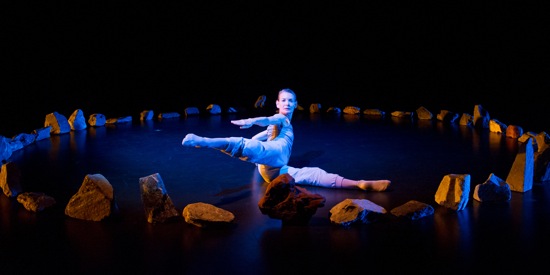Re-visiting The Old, Exploring The New
Molissa Fenley reconstructs two key works and fashions a new one at New York Live Arts, October 2 through 5.
Deborah Jowitt, Arts Journal - Dance Beat
October 6, 2013
 Photo © Ian Douglas |
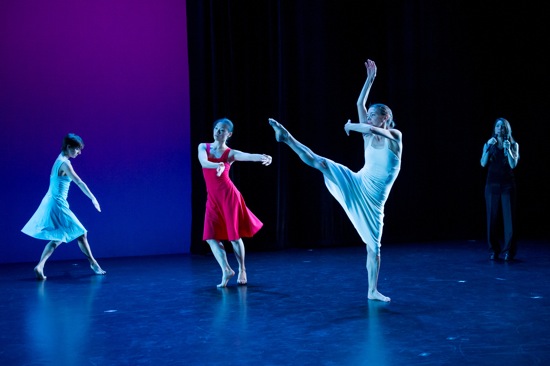
Molissa Fenley’s new Found Object. (L to R): Rebecca Chaleff, Peiling Kao, Molissa Fenley, and composer-vocalist Erin Gee. Photo: Ian Douglas
Elizabeth Streb is in the house! Not everyone at New York Live Arts for the opening night of Molissa Fenley and Company’s season would understand the exclamation point. I don’t deny Streb’s celebrity status in the downtown dance world, but the enthusiastic punctuation is there because, over 30 years ago, Streb was one of four young performers in Mix, one of the first works that introduced Fenley’s choreography to a New York audience. The year was 1979, and the place was the Kitchen Center for Video and Dance, then situated at the corner of Broome and Wooster. Eric Bogosian was the dance curator.
Sally Banes wrote in the Soho News that Fenley’s was the best new choreography that she had seen to date. And she understood that Mix didn’t display over-the-moon newness. Fenley, it was clear, was in love with repetition. And we knew repetition. Lucinda Childs and Laura Dean had taught us to look at dance steps and geometric patterns over and over, patiently watching them change in minimal ways. They had also re-investigated what footwork had to offer dance; with the exception of Merce Cunningham, few choreographers outside ballet kept the performers’ feet busy, preferring to give the torso and arms a workout and let the legs carry them along.
But Fenley had her own style, born of her heritage and her influences (her early upbringing in Nigeria had much to do with her love of ongoing rhythms, as did the fact that she came to dance late and from athletics). There was a kind of shared jubilation among the performers; a boisterous, peppy look to the steps; and a sense of ordeal gladly faced.
Energizer premiered the following year at Dance Theater Workshop, 19th Street quarters were then owned by Jerome Robbins and called the American Theater Laboratory). So Energizer, the revival of which closes Fenley’s NYLA program, is 33 years old. You’d never know it, except for the fact that no one born the year it premiered makes work like hers today.
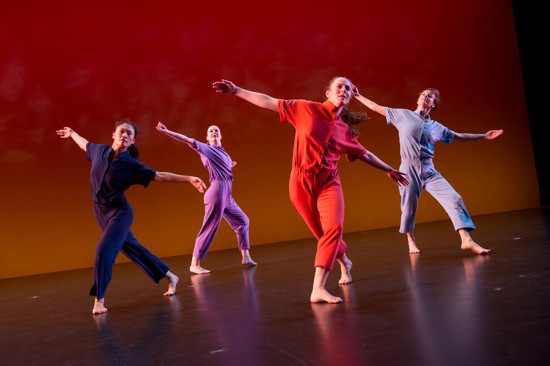
Fenley’s Energizer. (L to R): Peiling Kao, Cassandra Neville, Christiana Axelsen. and Rebecca Chaleff. Photo: Ian Douglas
The fastidiously reconstructed piece seems to inhabit existed an arduous, invigorating, ongoing present. Fenley constructed its patterns to grow, shrink, and shape-shift, but while watching it, you can’t remember (or don’t want to bother to remember) what has come before or how it might turn out. Even so, within its fierce minimalism, there’s a lot to see in its three sections.
Jill St. Coeur has recreated the original costumes by Ariel/Hayes Design and Yonson Pak. The four women who perform the first and third sections wear jumpsuits of different colors: persimmon (Christiana Axelsen), blue-gray (Rebecca Chaleff ), navy blue (Peiling Kao), and lavender (Cassandra Neville). David Moodey’s lighting includes a backdrop whose shadowy, luminescent gray patterns sometimes suggest ocean, sometimes stratus clouds, and sometimes tree branches.
The colors vivify and particularize the patterns. The women, in other words, don’t look like worker bees. As they circle, pin down the corners of a square, criss-cross, meet in the middle, and go back where they came from, their individual colors in motion could imply weaving, but, of course, no static, finished tapestry results. Mark Freedman’s recorded score maintains a strong percussive beat with other sounds feeding in and out. You can hear the women’s feet too, as the women walk, run, gallop, sashay, hop, leap, kick, and turn. Fenley has always used her arms distinctively, and the dancers have learned how to slash theirs through the air, the palms of their hands flat, the fingers held together. For her, a curved arm isn’t a sweet frame; it’s an arch constructed of something substantial yet malleable. Occasionally the four women do little things with their shoulders, or swing their hips jauntily around, or touch one another lightly. The springiness of the steps gives a buoyancy to the patterns, but also contributes to the dancers’ labor. How can they keep doing this? How long will they be able to look spirited and at ease?
There are two breaks in which they catch their breaths offstage, and we contemplate the backdrop. But there are also costume changes. For the second section Axelsen reappears in a sleeveless outfit with Fenley, who is dressed similarly. It cools the eye to watch just the two of them join and separate their patterns. After the second pause, the dancers feed in one by one—Kao first, then Chaleff, then Neville, then Axelsen (back in her original attire). Now they’re damp and beginning to tire, but they perform with undiminished verve. If you’ve dared to tune out briefly, their valor, their rhythmic acuity, and your own desire to figure out how Fenley devised these designs add a kind of drama to the over and over and over again steps.
Between 1988 and 1997, Fenley focused on creating solos for herself. The first of her two NYLA programs opens with one she made in 1989: The Floor Dances. It was, she has said, her response to an ecological disaster: the hundreds of thousands of barrels of oil spilled in Alaskan waters by the tanker Exxon Valdez. In the space of several days, oil covered the coast, the waters, and the wildlife inhabitants. Fenley performs the dance in a circle of rocks created by the British land artist Richard Long. The setting invokes an ancient ritual place, and Moodey’s beautiful lighting suggest both the artic sea and its lowering skies.
The subtle and eloquent solo, as its title implies, is not about brisk footwork. Nor does it depict struggle in any realistic way. Just as part of the accompanying score, Henryk Mikolaj Górecki’s Symphony of Sorrowful Songs for soprano and orchestra, op. 36, memorializes a prayer written by a Polish girl on the cell wall of a Gestapo prison, Fenley seems to be remembering the trapped and immobilized wild life along the Alaskan coast. She performs almost entirely in a sitting position—stretching her arms and legs, inching slowly forward, curling in, reaching out, scanning the distance. Sometimes she moves her hand toward her mouth, fingers gathered like the beak of a bird, and, for a second, with that single gesture, she becomes the hungry, the feeder, and the fed. She also briefly uses one hand like a mirror (perhaps to test her breathing) and points her elbows upward like straining wings.
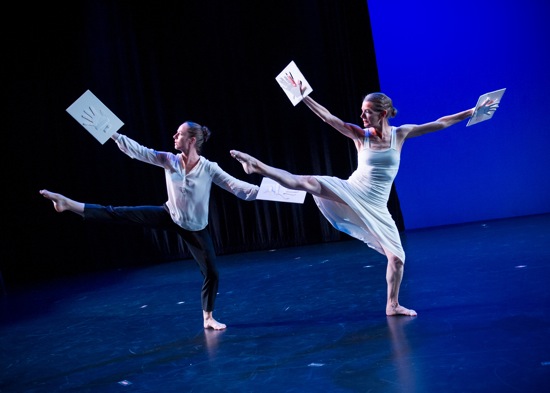
(L to R): Christiana Axelsen and Molissa Fenley in Found Object‘s “Dance for Jene.” Photo: Ian Douglas
In the last few years, Fenley has been adventurous in her methods. For her 2010 The Prop Dances, she commissioned artists to create props that she and her dancers could manipulate, then let those objects shape her choreographic choices. In 2012, John Cage’s Credo in Us inspired her to follow the composer into chance procedures—requesting from her dancers lists of images that Cage’s music suggested to them, and then building on selections drawn from those sources. Her new Found Object also responded to input outside her own experience. She asked novelist Rudy Wurlitzer, poet Joy Harjo, and playwright John Guare to give her instructions, each of which would generate about five minutes of material for her to work with. To open Found Object, she re-purposed the white paddles with indentations for the dancers’ hands that Jene Highstein had designed for The Prop Dances; the duet, in which Fenley and Axelsen wield these fanlike extensions as they dance, can be thought of as a memorial for Highstein, who died last April.
Wurlitzer’s instructions for “Circulus” have to do with spatial patterns, and it’s impossible to tell exactly what Harjo’s contribution to “Everybody Has a Heartache” was. But both produce lively onstage dancing. In the latter, co-choreographers Fenley, Pei, and Cheleff (wearing short, flippy dresses by Ada Hatcher) move in and out of spirited, unpredictable patterns to the remarkable onstage vocal antics of Erin Gee. Wielding two microphones (you might almost call them dueling microphones), the composer-performer emits a rhythmic little storm of clicks and creakings and other sounds not often heard proceeding from the human mouth.
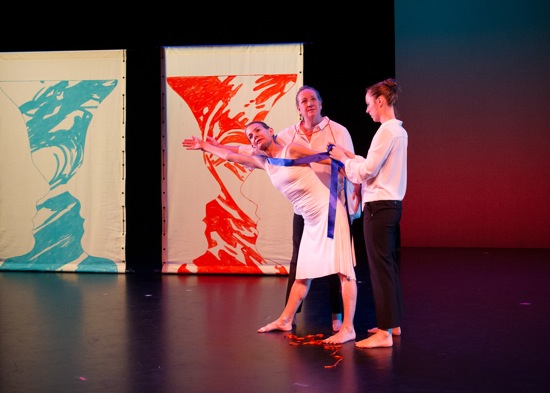
Fenley tied up by Rosemary Quinn (L) and Christiana Axelsen in Found Object to text contributed by John Guare. Photo: Ian Douglas
Guare offered Fenley two texts—one to do with drying flowers for a bouquet, the other taken from the 1949 Geneva Convention articles that relate to the treatment of prisoners. Two panels by Roy Fowler descend; each presents , a chalice-shaped image—one in red, the other in blue. Rosemary Quinn, who co-choreographed this section of Found Object, speaks some of the text; so does Fenley, as she kites around with Pei and Cheleff. Axelsen, costumed like Quinn in black pants and a white shirt, shadows Quinn inscrutably.
At the end, Quinn and Axelsen drape a blue ribbon and a red string around Fenley. They deliberately don’t do a very efficient job, whether they’re attempting to bind a prisoner or finish off a bouquet. The flower instructions gets the last optimistically perky word from Fenley as to the possible result: “. . .or give as a gift.”
The effect of the new work is that of a very smart artist at play—venturing out an unfamiliar limb and making it into a perch she can enjoy, while getting a fresh view of the dance territory she’s been exploring for decades. Her adventurousness has taken many forms; it’s after Found Object that she and the wily dancers who work with her suit up to tackle the arduous retrospective trek through Energizer.
I was unable to see the company’s second NYLA program, on which Holley Farmer performed Fenley 1993 solo Witches’ Float as the opener. What I missed: Kiki Smith’s large, pastel-colored supine figures, Alvin Lucier’s music, and Farmer wearing a white dhoti and red body paint, channeling—no doubt in her own distinctive way—the Fenley of ten years ago.
http://www.artsjournal.com/dancebeat/2013/10/re-visiting-the-old-exploring-the-new/
Two Pianos by Phoebe Legere filmed at Yaddo, Saratoga Springs, New York
August 15-December 31, 2025
Click here for details
Emily Harvey Foundation
November 4 - December 2, 2025
Click here for details
Cavana dei Miracoli
November 24, 2025, 7pm
Click here for details
Untitled (Haiku)


